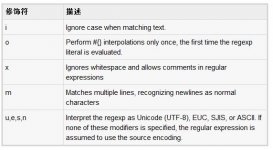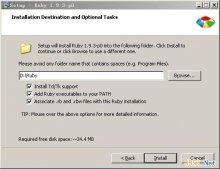Ruby 全局变量
全局变量以 $ 开头。未初始化的全局变量的值为 nil,在使用 -w 选项后,会产生警告。
给全局变量赋值会改变全局状态,所以不建议使用全局变量。
下面的实例显示了全局变量的用法。
|
1
2
3
4
5
6
7
8
9
10
11
12
13
14
15
16
17
18
|
#!/usr/bin/ruby $global_variable = 10class Class1 def print_global puts "Global variable in Class1 is #$global_variable" endendclass Class2 def print_global puts "Global variable in Class2 is #$global_variable" endend class1obj = Class1.newclass1obj.print_globalclass2obj = Class2.newclass2obj.print_global |
在这里,$global_variable 是全局变量。这将产生以下结果:
注意:在 Ruby 中,您可以通过在变量或常量前面放置 # 字符,来访问任何变量或常量的值。
|
1
2
|
Global variable in Class1 is 10Global variable in Class2 is 10 |
Ruby 实例变量
实例变量以 @ 开头。未初始化的实例变量的值为 nil,在使用 -w 选项后,会产生警告。
下面的实例显示了实例变量的用法。
|
1
2
3
4
5
6
7
8
9
10
11
12
13
14
15
16
17
18
19
20
21
22
|
#!/usr/bin/ruby class Customer def initialize(id, name, addr) @cust_id=id @cust_name=name @cust_addr=addr end def display_details() puts "Customer id #@cust_id" puts "Customer name #@cust_name" puts "Customer address #@cust_addr" endend # 创建对象cust1=Customer.new("1", "John", "Wisdom Apartments, Ludhiya")cust2=Customer.new("2", "Poul", "New Empire road, Khandala") # 调用方法cust1.display_details()cust2.display_details() |
在这里,@cust_id、@cust_name 和 @cust_addr 是实例变量。这将产生以下结果:
|
1
2
3
4
5
6
|
Customer id 1Customer name JohnCustomer address Wisdom Apartments, LudhiyaCustomer id 2Customer name PoulCustomer address New Empire road, Khandala |
Ruby 类变量
类变量以 @@ 开头,且必须初始化后才能在方法定义中使用。
引用一个未初始化的类变量会产生错误。类变量在定义它的类或模块的子类或子模块中可共享使用。
在使用 -w 选项后,重载类变量会产生警告。
下面的实例显示了类变量的用法。
|
1
2
3
4
5
6
7
8
9
10
11
12
13
14
15
16
17
18
19
20
21
22
23
24
25
26
27
|
#!/usr/bin/ruby class Customer @@no_of_customers=0 def initialize(id, name, addr) @cust_id=id @cust_name=name @cust_addr=addr end def display_details() puts "Customer id #@cust_id" puts "Customer name #@cust_name" puts "Customer address #@cust_addr" end def total_no_of_customers() @@no_of_customers += 1 puts "Total number of customers: #@@no_of_customers" endend # 创建对象cust1=Customer.new("1", "John", "Wisdom Apartments, Ludhiya")cust2=Customer.new("2", "Poul", "New Empire road, Khandala") # 调用方法cust1.total_no_of_customers()cust2.total_no_of_customers() |
在这里,@@no_of_customers 是类变量。这将产生以下结果:
|
1
2
|
Total number of customers: 1Total number of customers: 2 |
Ruby 局部变量
局部变量以小写字母或下划线 _ 开头。局部变量的作用域从 class、module、def 或 do 到相对应的结尾或者从左大括号到右大括号 {}。
当调用一个未初始化的局部变量时,它被解释为调用一个不带参数的方法。
对未初始化的局部变量赋值也可以当作是变量声明。变量会一直存在,直到当前域结束为止。局部变量的生命周期在 Ruby 解析程序时确定。
在上面的实例中,局部变量是 id、name 和 addr。
Ruby 常量
常量以大写字母开头。定义在类或模块内的常量可以从类或模块的内部访问,定义在类或模块外的常量可以被全局访问。
常量不能定义在方法内。引用一个未初始化的常量会产生错误。对已经初始化的常量赋值会产生警告。
|
1
2
3
4
5
6
7
8
9
10
11
12
13
14
|
#!/usr/bin/ruby class Example VAR1 = 100 VAR2 = 200 def show puts "Value of first Constant is #{VAR1}" puts "Value of second Constant is #{VAR2}" endend # 创建对象object=Example.new()object.show |
在这里,VAR1 和 VAR2 是常量。这将产生以下结果:
|
1
2
|
Value of first Constant is 100Value of second Constant is 200 |
Ruby 伪变量
它们是特殊的变量,有着局部变量的外观,但行为却像常量。您不能给这些变量赋任何值。
self: 当前方法的接收器对象。
true: 代表 true 的值。
false: 代表 false 的值。
nil: 代表 undefined 的值。
__FILE__: 当前源文件的名称。
__LINE__: 当前行在源文件中的编号。
Ruby 基本文字
Ruby 用于文字的规则简单而又直观。这部分解释了 Ruby 中所有的基本文字。
整数
Ruby 支持整数。整数范围从 -230 到 230-1 或 -262 到 262-1。在这个范围内的整数是类 Fixnum 的对象,在这个范围外的整数存储在类 Bignum 的对象中。
您可以在整数前使用一个可选的前导符号,一个可选的基础指标(0 对应 octal,0x 对应 hex,0b 对应 binary),后跟一串数字。下划线字符在数字字符串中被忽略。
您可以获取一个 ASCII 字符或一个用问号标记的转义序列的整数值。
实例:
|
1
2
3
4
5
6
7
8
9
|
123 # Fixnum 十进制1_234 # Fixnum 带有下划线的十进制-500 # 负的 Fixnum0377 # 八进制0xff # 十六进制0b1011 # 二进制?a # 'a' 的字符编码?\n # 换行符(0x0a)的编码12345678901234567890 # Bignum |
注意:类和对象会在本教程中一个单独的章节进行讲解。
浮点数
Ruby 支持浮点数。它们是带有小数的数字。浮点数是类 Float 的对象,且可以是下列中任意一个。
实例:
|
1
2
3
4
|
123.4 # 浮点值1.0e6 # 科学记数法4E20 # 不是必需的4e+20 # 指数前的符号 |
字符串文字
Ruby 字符串简单地说是一个 8 位字节序列,它们是类 String 的对象。双引号标记的字符串允许替换和使用反斜线符号,单引号标记的字符串不允许替换,且只允许使用 \\ 和 \' 两个反斜线符号。
实例:
|
1
2
3
4
|
#!/usr/bin/ruby -w puts 'escape using "\\"';puts 'That\'s right'; |
这将产生以下结果:
|
1
2
|
escape using "\"That's right |
您可以使用序列 #{ expr } 替换任意 Ruby 表达式的值为一个字符串。在这里,expr 可以是任意的 Ruby 表达式。
|
1
2
3
|
#!/usr/bin/ruby -w puts "Multiplication Value : #{24*60*60}"; |
这将产生以下结果:
|
1
|
Multiplication Value : 86400 |
反斜线符号
下表列出了 Ruby 支持的反斜线符号:

Ruby 数组
Ruby 数组是在方括号内放置一系列逗号分隔的对象引用。尾部的逗号会被忽略。
实例:
|
1
2
3
4
5
6
|
#!/usr/bin/ruby ary = [ "fred", 10, 3.14, "This is a string", "last element", ]ary.each do |i| puts iend |
这将产生以下结果:
|
1
2
3
4
5
|
fred103.14This is a stringlast element |
如需了解更多有关 Ruby 数组的细节,请查看 Ruby 数组(Array)。
Ruby 哈希
Ruby 哈希是在大括号内放置一系列键/值对,键和值之间使用逗号和序列 => 分隔。尾部的逗号会被忽略。
实例:
|
1
2
3
4
5
6
|
#!/usr/bin/ruby hsh = colors = { "red" => 0xf00, "green" => 0x0f0, "blue" => 0x00f }hsh.each do |key, value| print key, " is ", value, "\n"end |
这将产生以下结果:
|
1
2
3
|
green is 240red is 3840blue is 15 |
Ruby 范围
一个范围表示一个时间间隔。范围是通过设置一个开始值和一个结束值来表示。范围可使用 s..e 和 s...e 来构造,或者通过 Range.new 来构造。
使用 .. 构造的范围从开始值运行到结束值(包含结束值)。使用 ... 构造的范围从开始值运行到结束值(不包含结束值)。当作为一个迭代器使用时,范围会返回序列中的每个值。
范围 (1..5) 意味着它包含值 1, 2, 3, 4, 5,范围 (1...5) 意味着它包含值 1, 2, 3, 4 。
实例:
|
1
2
3
4
5
|
#!/usr/bin/ruby (10..15).each do |n| print n, ' 'end |
这将产生以下结果:
|
1
|
10 11 12 13 14 15 |




